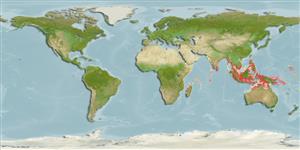Elasmobranchii (sharks and rays) >
Myliobatiformes (Stingrays) >
Gymnuridae (Butterfly rays)
Etymology: Gymnura: Greek, gymnos = naked + Greek, oura = tail (Ref. 45335).
More on author: Bleeker.
Environment: milieu / climate zone / depth range / distribution range
Ecology
Marine; reef-associated; depth range 28 - 37 m (Ref. 9918). Tropical
Eastern Indian Ocean and Western Central Pacific: India to Indonesia, including Singapore and Thailand.
Length at first maturity / Size / Weight / Age
Maturity: Lm 47.6, range 47 - ? cm
Max length : 106 cm WD male/unsexed; (Ref. 58048); common length : 20.0 cm WD male/unsexed; (Ref. 27550)
Demersal inshore, in shallow depths to at least 37 m (Ref.58048). Also found offshore (Ref. 9918). Ovoviviparous (Ref. 50449). Smallest individual was 27 cm WD. Caught often by demersal trawl, trammel and gillnet fisheries, and occasionally using tangle nets. Utilized for its meat, but of limited value due to its typically small size (Ref.58048).
Life cycle and mating behavior
Maturity | Reproduction | Spawning | Eggs | Fecundity | Larvae
Exhibit ovoviparity (aplacental viviparity), with embryos feeding initially on yolk, then receiving additional nourishment from the mother by indirect absorption of uterine fluid enriched with mucus, fat or protein through specialised structures (Ref. 50449). Distinct pairing with embrace (Ref. 205).
Compagno, L.J.V., 1999. Checklist of living elasmobranchs. p. 471-498. In W.C. Hamlett (ed.) Sharks, skates, and rays: the biology of elasmobranch fishes. Johns Hopkins University Press, Maryland. (Ref. 35766)
IUCN Red List Status (Ref. 130435: Version 2024-2)
Human uses
Fisheries: commercial
Tools
Special reports
Download XML
Internet sources
Estimates based on models
Preferred temperature (Ref.
123201): 27.2 - 28.8, mean 28.2 °C (based on 91 cells).
Phylogenetic diversity index (Ref.
82804): PD
50 = 0.5000 [Uniqueness, from 0.5 = low to 2.0 = high].
Bayesian length-weight: a=0.00776 (0.00351 - 0.01718), b=3.09 (2.89 - 3.29), in cm total length, based on LWR estimates for this (Sub)family-body shape (Ref.
93245).
Trophic level (Ref.
69278): 3.8 ±0.6 se; based on size and trophs of closest relatives
Resilience (Ref.
120179): Very Low, minimum population doubling time more than 14 years (Fec assumed to be <10).
Fishing Vulnerability (Ref.
59153): Moderate vulnerability (43 of 100).
